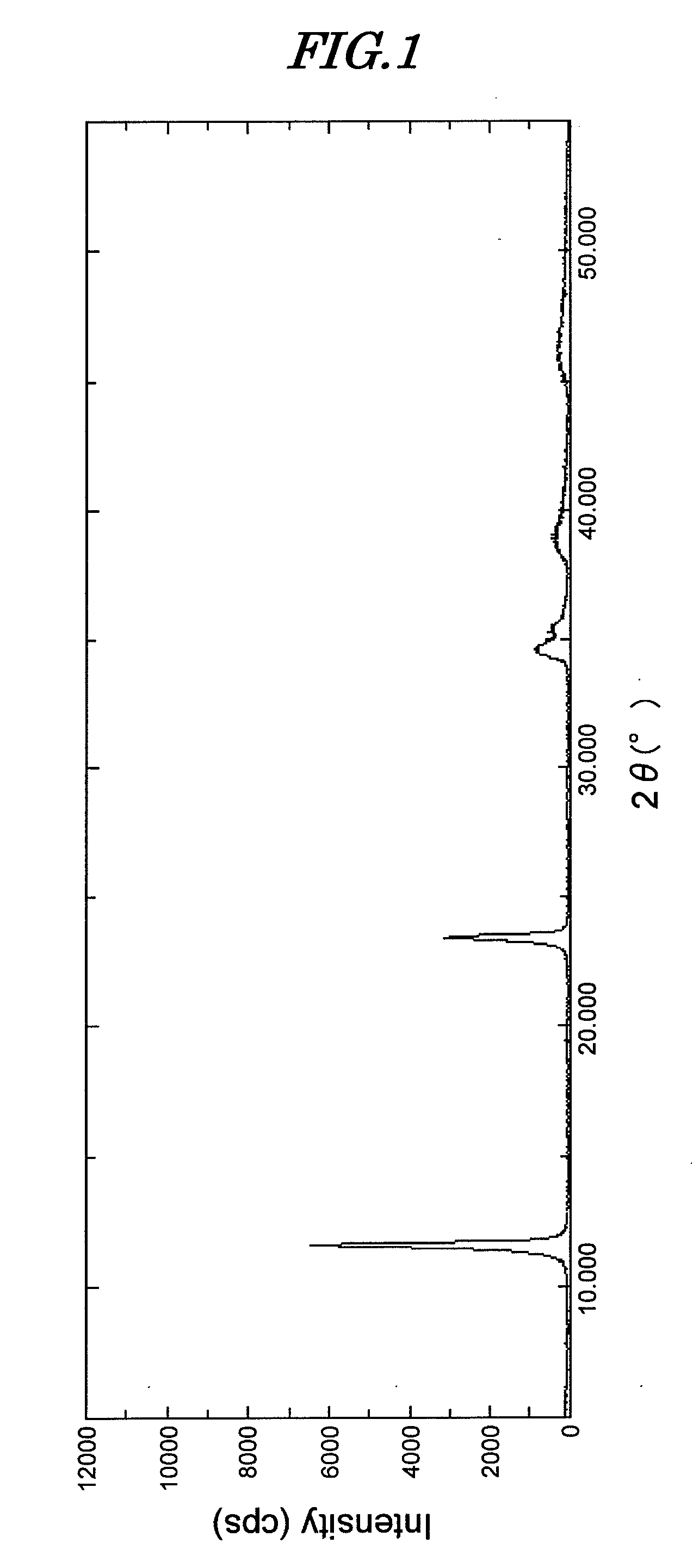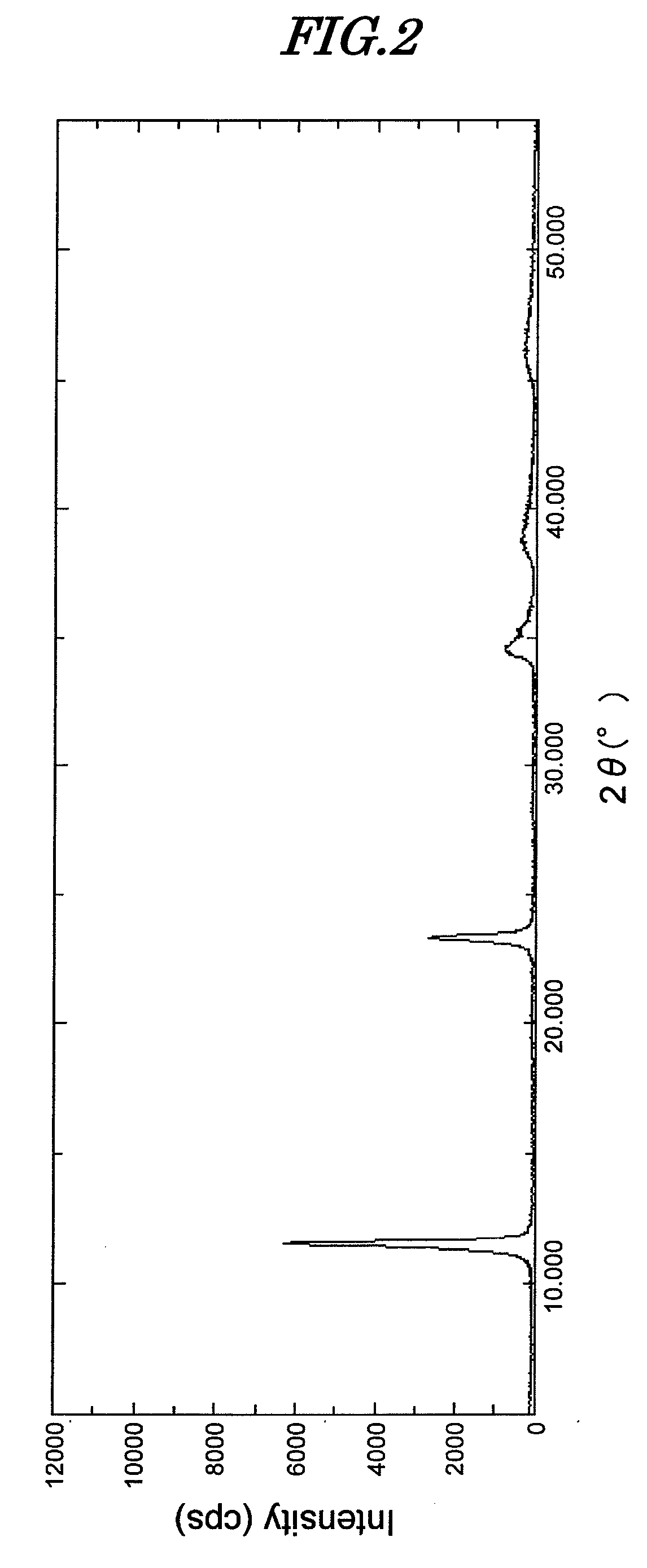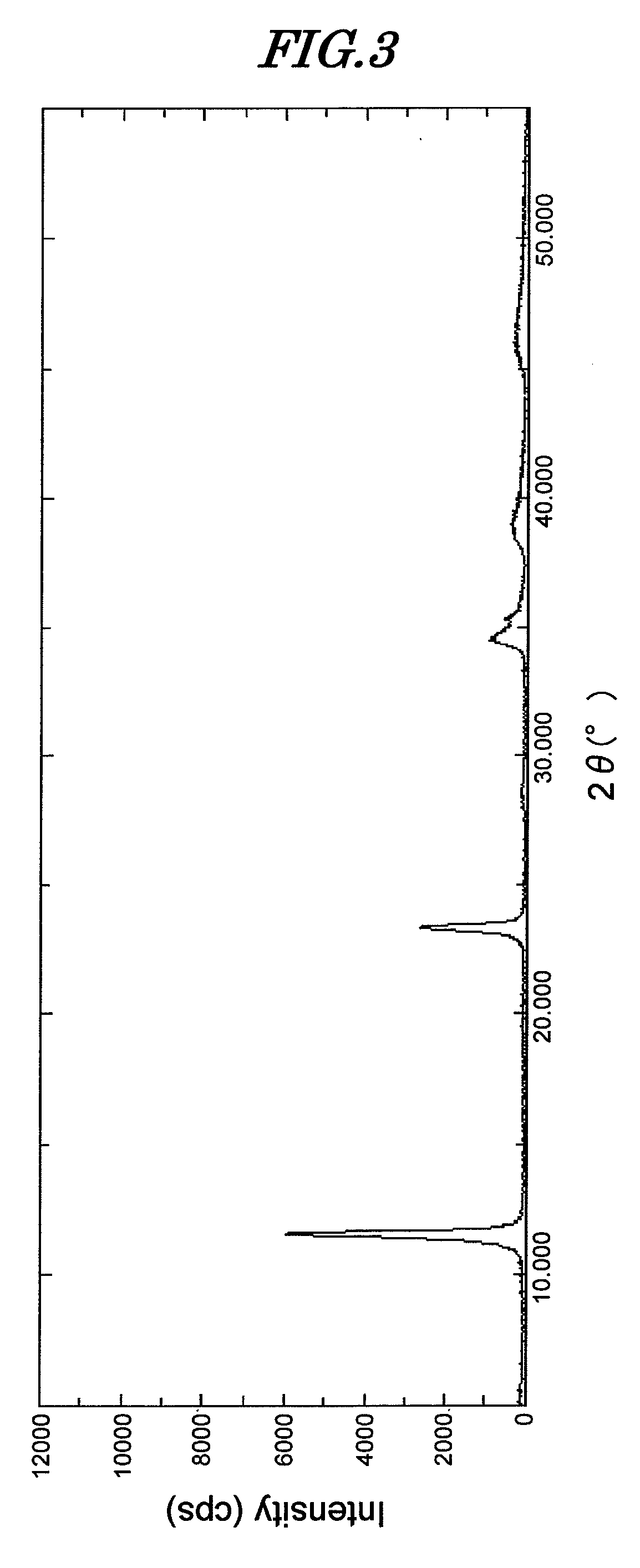Hydrotalcite compound, process for producing same, inorganic ion scavenger, composition, and electronic component-sealing resin composition
a technology of hydrotalcite and inorganic ions, which is applied in the direction of other chemical processes, semiconductor/solid-state device details, non-metal conductors, etc., to achieve excellent metal corrosion inhibiting effect and high performan
- Summary
- Abstract
- Description
- Claims
- Application Information
AI Technical Summary
Benefits of technology
Problems solved by technology
Method used
Image
Examples
example 1
[0123]134.6 g of magnesium nitrate hexahydrate and 93.8 g of aluminum nitrate nonahydrate were dissolved in 200 mL of ion exchanged water, and while maintaining this solution at 25° C. the pH was adjusted to 10.3 by adding a solution of 97.4 g of sodium carbonate and 120 g of sodium hydroxide dissolved in 1 L of ion exchanged water. A precipitate was quickly formed, but stirring was continued for 1 hour while keeping the temperature at 25° C. Aging was then carried out at 98° C. for 24 hours. After cooling, the precipitate was washed with ion exchanged water, thus giving a hydrotalcite compound (hereinafter, called compound A). When an analysis was carried out on compound A, it was found to be Mg4.5Al2(OH)13CO3·3.5H2O.
[0124]A powder X-ray measurement of this compound was carried out using a RINT 2400V type powder X-ray diffractometer (XRD) manufactured by Rigaku Corporation. The measurement conditions were 40 kV and 40 mA using copper as an X-ray emission target. The diffraction pat...
example 2
[0129]134.6 g of magnesium nitrate hexahydrate and 93.8 g of aluminum nitrate nonahydrate were dissolved in 200 mL of ion exchanged water, and while maintaining this solution at 25° C. the pH was adjusted to 11 with a solution of 37.1 g of sodium carbonate and 120 g of sodium hydroxide dissolved in 1 L of ion exchanged water. A precipitate was quickly formed, but stirring was continued for 1 hour while keeping the temperature at 25° C. Aging was then carried out at 98° C. for 24 hours. After cooling, the precipitate was washed with ion exchanged water, thus giving a hydrotalcite compound (hereinafter, called compound B). When an analysis was carried out on compound B, it was found to be Mg4.2Al2(OH)12.4CO3·3.5H2O.
[0130]A powder X-ray diffraction (XRD) measurement of compound B was carried out. The diffraction pattern thereof is shown in FIG. 2.
[0131]The compound was found to have a hydrotalcite peak, and the peak intensity at 2θ=11.52° was 6,200 cps.
example 3
[0132]134.6 g of magnesium nitrate hexahydrate and 93.8 g of aluminum nitrate nonahydrate were dissolved in 200 mL of ion exchanged water, and while maintaining this solution at 25° C. the pH was adjusted to 10 with a solution of 37.1 g of sodium carbonate and 120 g of sodium hydroxide dissolved in 1 L of ion exchanged water. A precipitate was quickly formed, but stirring was continued for 1 hour while keeping the temperature at 25° C. Aging was then carried out at 95° C. for 24 hours. After cooling, the precipitate was washed with ion exchanged water, thus giving a hydrotalcite compound (hereinafter, called compound C). When an analysis was carried out on this compound, it was found to be Mg4.2Al2(OH)12.4CO3·3.5H2O.
[0133]A powder X-ray diffraction (XRD) measurement of this compound was carried out. The diffraction pattern thereof is shown in FIG. 3. The compound was found to have a hydrotalcite peak, and the peak intensity at 2θ=11.52° was 5,800 cps.
PUM
| Property | Measurement | Unit |
|---|---|---|
| Temperature | aaaaa | aaaaa |
| Temperature | aaaaa | aaaaa |
| Temperature | aaaaa | aaaaa |
Abstract
Description
Claims
Application Information
 Login to View More
Login to View More - R&D
- Intellectual Property
- Life Sciences
- Materials
- Tech Scout
- Unparalleled Data Quality
- Higher Quality Content
- 60% Fewer Hallucinations
Browse by: Latest US Patents, China's latest patents, Technical Efficacy Thesaurus, Application Domain, Technology Topic, Popular Technical Reports.
© 2025 PatSnap. All rights reserved.Legal|Privacy policy|Modern Slavery Act Transparency Statement|Sitemap|About US| Contact US: help@patsnap.com



